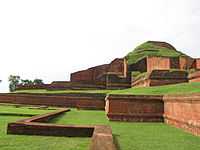Bargi
| Part of a series on the | ||||
| History of Bengal | ||||
|---|---|---|---|---|
 | ||||
| Ancient Bengal | ||||
|
||||
| Classical Bengal | ||||
|
||||
| Medieval Bengal | ||||
|
||||
| Modern Bengal | ||||
| See also | ||||
| Bangladesh, West Bengal | ||||
Bargis were group of Maratha people indulged in large scale plundering of the countryside of western part of Bengal for about ten years (1741–1751). Bargi invasions took place almost as an annual event.
Etymology
The Hatkar formerly when going on any expedition, took only a blanket seven hands long and a bear-spear (Barcha/Barchi in Marathi), and that on this account they were called Bargir, or Barga Dhangars or Bargi.[1][2]
Bargi is corruption of a Marathi word Bargir which meant Horsemen who were provided with horses and arms by the Maratha Empire who were exclusively Hatkar in contrast to the Shiledar, who had their own horses and arms.[3] The temper of Hatkars is said to be obstinate and quarrelsome.[4][5]
Impact
The repeated raids played on the creative impulse of the people.
- chhele ghumalo, pada judalo bargi elo deshe
bulbulite dhan kheyechhe, khajna debo kise?
ছেলে ঘুমালো পাড়া জুড়ালো বর্গী এল দেশে
বুলবুলিতে ধান খেয়েছে খাজনা দেব কিসে
ধান ফুরোলো পান ফুরোলো খাজনার উপায় কি?
আর কটা দিন সবুর কর রসুন বুনেছি।
- When the children fall asleep, silence sets in, the Bargis come to our lands
Bulbulis (birds) have eaten the grains, how shall I pay the rent?[6]
History
Alivardi Khan became Nawab of Bengal in April 1740, after defeating and killing Sarfraz Khan. His rule was challenged by Sarfraj Khan’s brother-in-law Rustam Jung, who was naib nazim (deputy governor) of Orissa. Alivardi defeated him in a battle at Falwaei, near Balasore, placed his own nephew as naib nazim of Orissa and left for his capital, Murshidabad. Rustam Jung sought the assistance of the Maratha ruler of Nagpur, Raghoji I Bhonsle. He regained control of Orissa with the assistance of Marathas, who in the process discovered how easy it was to plunder the rich countryside in Bengal. Alivardi returned to Orissa and again defeated Rustam Jung, but before he returned to Murshidabad, a Maratha cavalry under Bhaskar Pandit was sent to Bengal by Bhonsle. They entered through Panchet and started looting the countryside.[3][7]
For about ten years, the Bargis raided and plundered Bengal every year. Contemporary chroniclers have left behind vivid descriptions of Bargi terror, their hit-and-run tactics and the helplesness of the Nawabab’s army in checking them. Alivardi showed exemplary courage and military skill in every frontal battle that took place, but the objective of the Bargis was not occupation of territory but plundering; they looted and burned bazaars.[3][7] The Nawab’s soldiers could not match the Maratha horsemen in speed and manoevureability. Only the Ganges -Bhagirathi river line proved a barrier to their movement. They crossed it only on a few occasions.[3]
The Bargi invasions came to an end in May 1751 after the Nawab and the Marathas reached an agreement, including the secession of Orissa.[3]
See also
- Hatkar
- Dhangar
- Maratha Ditch
- Maratha empire
References
- ↑ The Castes and Tribes of H.E.H. the Nizam's Dominions, by Syed Siraj ul Hassan
- ↑ The Tribes and Castes of Bombay by Reginald Edward Enthoven
- ↑ 3.0 3.1 3.2 3.3 3.4 Sengupta, Nitish, History of the Bengali-speaking People, 2001/2002, pp.132-137, UBS Publishers’ Distributors Pvt. Ltd., ISBN 81-7476-355-4
- ↑ The Castes and Tribes of H.E.H. the Nizam's Dominions, by Syed Siraj ul Hassan
- ↑ The Tribes and Castes of Bombay by Reginald Edward Enthoven
- ↑ Ahmed, Wakil. "Folk Literature". Banglapedia. Asiatic Society of Bangladesh. Archived from the original on 15 February 2008. Retrieved 2008-02-21.
- ↑ 7.0 7.1 Shah, Mohammad. "Maratha Raids". Banglapedia. Asiatic Society of Bangladesh. Archived from the original on 9 January 2008. Retrieved 2008-02-21.